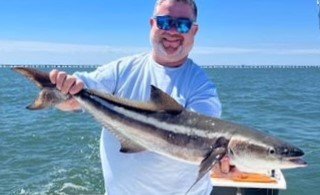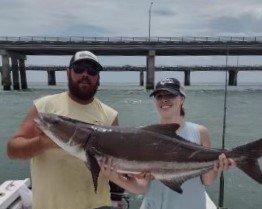
By Bill Hall –
The much anticipated opening of the Virginia cobia season opened Wednesday, June 15, and if the preseason is any indication for the legal season, this should be another good year for the hard-fighting sport fish. The regulations involving cobia are a bit complicated and confusing, but anglers are allowed one fish per person, but no more than two fish per boat, regardless of how many people are aboard the boat.
The minimum size for a cobia is 40 inches, and only one fish over 50 inches is allowed on a boat. In addition to a recreational fishing license, there is a free Virginia Marine Resources Committee (VMRC) permit that is also required to target and keep a cobia and all of your fishing trips involving cobia fishing (whether successful or not) must be reported to a VMRC website. Once you have mastered all of the legal requirements, you have until Sept. 15, to go out and battle one of these bruisers.
Upper Shore – Alan Ring, at the Sea Hawk Sports Center, told me flounder have started to settle into their summer pattern, with the best fishing starting to occur closer to the inlets. Ring and his crew enjoyed success out of Folly Creek and Wachapreague over the weekend while employing double hook rigs with silversides baited on the top hook with a Berkley Gulp and a live minnow and Gulp on the bottom hook. Ring said the shop just received a supply of fresh bunker (menhaden), bunker chum, and live eels for the Virginia cobia season, which opened on Wednesday. In the Maryland portion of the Chesapeake Bay, anglers have enjoyed success with striped bass and the occasional speckled trout by casting Rap-10s and Mirrolures over submerged structure along the river and creek mouths.
Chincoteague – Jimmy Vasiliou, at Captain Steve’s Bait and Tackle, said this week has been “very eventful” in the surf, with sharks over 6 feet caught and released, as well as plenty of tasty kingfish (whiting) landed. A few red and black drum could still be caught with high low rigs and fishfinder rigs baited with peeler crabs, sand fleas, or cut spot, but the best of the drum action is over for the season.
In Chincoteague Bay, the flounder have been hit and miss with water clarity being the key to catching success. With the murky water, darker-colored Gulps and bucktails with live minnows are out-performing the traditional white and chartreuse color variations. Black seabass and large flounder action are occurring over the inshore wrecks. Offshore, dolphin (mahi) and yellowfin tuna catches have started to come in from the offshore canyons.

Wachapreague – Captain Lindsay Paul, at Trident Tackle, said the flounder fishing remains good as long as there is clean water. Limit catches have been made for those anglers willing to put in the effort. Most anglers have been using gulp-minnow combinations. Paul had not heard of any recent drum catches in the inlet or off the beach and thinks the fish may have already migrated out of the area. Black sea bass fishing over the wrecks remains good and boats fishing offshore in the Washington Canyon have had success with tuna.
Amanda Manzella, at the Wachapreague Inn, reported the Teaser released a white marlin and boated several yellowfin tuna on a recent trip.
Lower Shore – Dez Louie, at Oceans East – Eastern Shore, said cobia have been numerous in the lower bay, with fish being found from the Chesapeake Bay Bridge-Tunnel north to above Cape Charles. Both sight casting with live eels and bucktails and bottom fishing with cut bunker have been effective cobia-catching techniques. Louie wanted to remind anglers they need a VMRC Recreational Cobia Permit to target or keep cobia and that anglers are required to report their cobia trips and catches.
Schools of big red drum are still popping up in the waters off Fisherman Island and out at the fourth island of the bridge-tunnel. The fourth island is also holding a school of Atlantic spadefish. Louie said steady flounder fishing is occurring in the Ditch and up out of Oyster. The waters around the concrete ships are producing mullet (whiting) and croakers, while recent catches off the Kiptopeke Pier have consisted mostly of ribbonfish.
Jeb Brady, at Baileys Bait & Tackle, told me the cobia fishing continues to improve since the season opened on Wednesday. Brady reported some large fish have been caught while chumming and fishing cut bunker on the bottom in the Latimer Sholas area. Anglers sight casting live eels have seen nice-sized fish along the surface of the deeper waters near the Baltimore Channel. Brady was anticipating some large fish to be weighed in over the weekend. Other than cobia, red drum catches were still coming from the lower barrier island surf. Flounder catches were coming from along the bridge-tunnel and up in the Ditch. Sand mullet (whiting) catches are coming from the waters around the concrete ships and over the cabbage patch. Pier catches have consisted mostly of small croakers, trout, and a few flounder.
Bill Hall was the first Eastern Shore resident to achieve Virginia Salt Water Master Angler Status. He has been named Virginia Saltwater Angler of the Year and Virginia Saltwater Release Angler of the Year and is a Virginia Press Association award-winning sports columnist.


